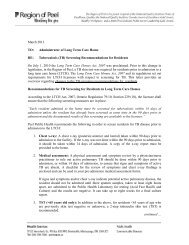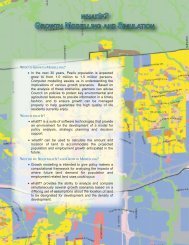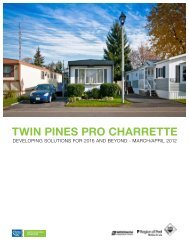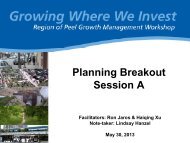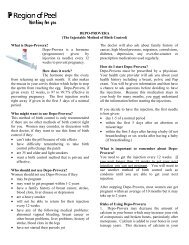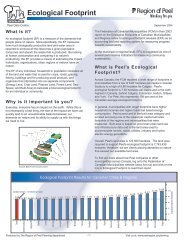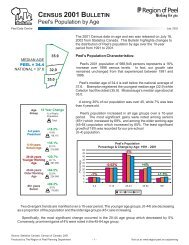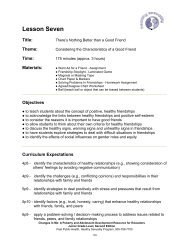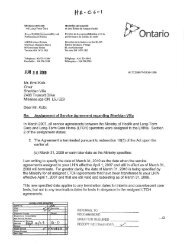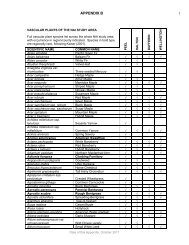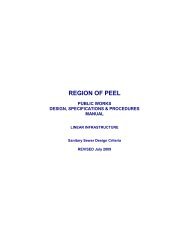FIFTH LINE – 22 SIDEROAD (LIMEHOUSE CA ... - Region of Peel
FIFTH LINE – 22 SIDEROAD (LIMEHOUSE CA ... - Region of Peel
FIFTH LINE – 22 SIDEROAD (LIMEHOUSE CA ... - Region of Peel
You also want an ePaper? Increase the reach of your titles
YUMPU automatically turns print PDFs into web optimized ePapers that Google loves.
<strong>FIFTH</strong> <strong>LINE</strong> <strong>–</strong> <strong>22</strong> <strong>SIDEROAD</strong><br />
(<strong>LIMEHOUSE</strong> <strong>CA</strong> AND AREA)<br />
Symphyotrichum pilosum var. pilosum White Heath Aster variety S5 G5T5<br />
Symphyotrichum urophyllum Arrow-leaved Aster S4 G4G5<br />
Teucrium canadense ssp. canadense Canada Germander S5? G5TR<br />
Triosteum aurantiacum C<strong>of</strong>fee Tinker's-weed S5 G5<br />
Site Condition and Disturbances<br />
This natural area is large, and while a good portion exists as a cohesive core area in and adjacent to<br />
the conservation area, other parts are highly fragmented with patches linked only narrowly. In spite<br />
for the fragmentation, the area still has high biodiversity and high habitat diversity.<br />
Forest age is variable and currently regenerating from historic land clearing for logging, agriculture<br />
and grazing purposes.<br />
Most <strong>of</strong> this area is part <strong>of</strong> Limehouse Conservation Area and this portion has been impacted by<br />
widespread well-marked trails (including the Bruce Trail) and the presence <strong>of</strong> two ball diamonds.<br />
Recreational use is light to moderate, littering is light. Some damage has been sustained by<br />
unauthorized ATV use, fire-pits and camping. Shotgun shells were found. The lime kilns have been<br />
vandalised in the past. Some trampling <strong>of</strong> limestone plants is apparent (North-South Environmental,<br />
2004).<br />
Non-native species are occasional to abundant and widespread. Part <strong>of</strong> this may be due to the area's<br />
history as a busy commercial area with rail lines running through the area as well as nearby. Notable<br />
problematic invasive species present here are Garlic Mustard (Alliaria petiolata), Common Buckthorn<br />
(Rhamnus cathartica), Dame’s Rocket (Hesperis matronalis) and Norway Maple (Acer platanoides).<br />
Remnants <strong>of</strong> early limestone quarry operations exist including lime kilns and a man-made pond.<br />
Some <strong>of</strong> the track-bed from an abandoned rail-way is also visible. An old building foundation, and<br />
discarded farm machinery are also present. Noise from a nearby active quarry can be heard from this<br />
site.<br />
Ecological Features and Functions<br />
All <strong>of</strong> this natural area is part <strong>of</strong> Limehouse Cliffs ESA (valley related).<br />
With forest communities greater than 4 ha, wetlands over 0.5 ha in size and cultural thicket/cultural<br />
savannah totalling over 10 ha, this natural area has the potential to support and sustain biodiversity,<br />
healthy ecosystem functions and to provide long-term resilience for the natural system. The riparian<br />
areas provide a transitional zone between terrestrial and aquatic habitats, helping to maintain the<br />
water quality <strong>of</strong> the creek, and providing a movement corridor for plants and wildlife.<br />
By containing a relatively high number <strong>of</strong> habitat types, this natural area has the potential for high<br />
biodiversity function, particularly for species that require more than one habitat type for their life<br />
needs. This natural area contains regionally rare vegetation communities and thus has the potential<br />
to support additional biodiversity above and beyond that found in common community types.<br />
Linkages to other natural areas exist to the north, upstream along Black Creek, and to the south and<br />
west along Black Creek in the downstream direction. Connectivity also exists between this natural<br />
area and smaller habitat patches to the north across <strong>22</strong> Sideroad and to the west across Fifth Line,<br />
although these connections are interrupted by manicured lots associated with residences. There is a<br />
broad area <strong>of</strong> linkage to with a natural area to the northeast, across Sixth Line. The relatively close<br />
proximity <strong>of</strong> other areas <strong>of</strong> natural habitat creates above-average potential for wildlife movement<br />
between natural areas, species dispersal and recovery from disturbance, creating additional<br />
resilience for the ecosystem.<br />
Date <strong>of</strong> this Site Summary: October 2011<br />
6



